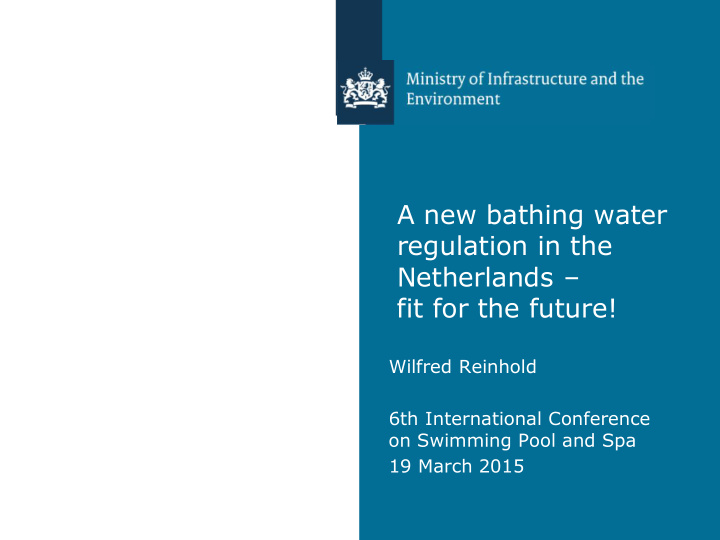



A new bathing water regulation in the Netherlands – fit for the future! Wilfred Reinhold 6th International Conference on Swimming Pool and Spa 19 March 2015
Current regulation • Dates from 1969 • Old standards for chemical, physical and microbiological water quality • Requirements for pool operation such as – capacity of the pumps – filter backwash procedure and frequency – volume of supplement/dilution water (30 liters of drinking water / bather / day) • Aim of regulation: achievement of a safe and healthy swimming pool environment through strict requirements • ±1500 public and semi-public swimming pools in the Netherlands 2 Ministry of Infrastructure and the Environment
Towards a new regulation From strict requirements towards regulation that specifies that the swimming pool environment should be safe and healthy for its users, regardless of the way pool operators achieve this goal Pool managers and operators get opportunity and responsibility to make their own choices in how to achieve this goal accommodates innovation & application of novel technologies. 3 Ministry of Infrastructure and the Environment
Consultation of local & provincial authorities and the public • Draft texts and reports published on www.internetconsulatie.nl • Period: September - November 2014 • >20 persons/organisations submitted comments • From short to quite long comments (dozens of pages) • In total: comments on nearly 300 aspects of the regulation • At this moment: finishing the processing of the commentary • Comments lead to changes in details, not in the structure of the proposed regulation 4 Ministry of Infrastructure and the Environment –
Duty of care Section 3 • Operator shall ensure that hygiene and safety in the swimming pool environment is sufficiently ensured • If operator knows / should suspect the bathing complex can cause adverse effects on hygiene / safety of visitors , he must take measures to prevent / limit those effects 5 Ministry of Infrastructure and the Environment
New parametric values for water and air Section 4 to 6 + Annex I Class I Class II Class III Free Available Bromate : ≤50 µg/l Available bound Chlorine: 1.0±0.5 chlorine : ≤0.6 mg/l Acidity (pH):7.30±0.30 Sum Trihalomethanes (as CHCl 3 ) : ≤50 µg/l Chlorate : ≤30 mg/l Transparency: floor of Pseudomonas aeruginosa ≤0/100 Urea : ≤2.0 mg/l pool Legionella: <100 cfu/l Intestinal enterococci : ≤0/100 Nitrate : ≤50 mg/l Spores of sulfitereducing Clostridia (SSRC): Hydrogen carbonate: ≤0/100 ≥40 mg/l Staphylococcus aureus : ≤0/100 Chloride: ≤800 mg/l KMnO4 – consumption : ≤3.0 mg/l O2 Turbidity : ≤0.50 FTE Trichloramines: ≤0.50 mg/m3 air Ozone : ≤120 ug/m3 1-hour air 6 Ministry of Infrastructure and the Environment
Risk analysis: Not entirely new • Operators already have experience in Risk analysis and management of legionella + Risk assessment and evaluation based on Health and Safety legislation + HACCP based on Consumer Legislation • Some operators have already decided for such an approach (responsibility , corporate culture, savings ) 7 Ministry of Infrastructure and the Environment
Risk analysis + management plan + measures Section 7 + Annex II • Pool managers analyses the apparent/ expected risks for health/safety of the users of the pool environment • Document the used method and results • Description of the measures to be taken • Attention for risk of Legionella • Carry out the management plan • Keep risk analysis+management plan up to date! • Save documents and results for inspection • Law enforcer must be able to inspect them 8 Ministry of Infrastructure and the Environment
Risk analysis Risk model = guideline Operator should take into account aspects such as: • design, operation and maintenance of technical installations • risk of drowning or suction trapment • risk of microbiological contamination of the water • prevention of overdose of chemicals • risk of malfunctioning of (parts of) the technical installation • health and safety aspects (such as slippery floors) • number and type of visitors (age, swimming skills, vulnerable groups) 9 Ministry of Infrastructure and the Environment
Special basins Section 8 to 13 (+ Annex III Swimming Ponds) • Shallow basins (≤ 50 cm) • Swimming Ponds (biological cleaning method) • Floating tanks (addition of magnesium sulphate or other salts in water) • Basins for single use by one person • Fish spas • Flowed through basins (water is constantly discharged; discharged water does not return) • Special parametric values/monitoring requirements • Special aspects for risk analysis and management 10 Ministry of Infrastructure and the Environment
Implementation & effects Additional cost for pools: • Analysing water & air: € 1060-2692 /yr • Risk Analysis: avg. € 2412 euro • Resulting measures RA: avg. € 240 • Extra time control: avg. 95 euro Financial benefits : May be present but unquantifiable Possible environmental impact : New approach could lead to reduced use of water, energy and chemicals in the (near) future. • It is planned that the new regulation will come into force in January 2016 11
Thank you for your attention! 12
Recommend
More recommend